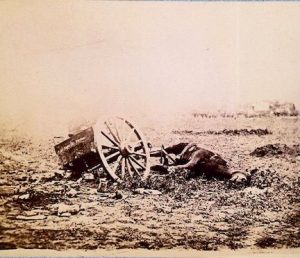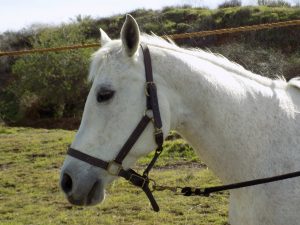Equestrian Casualties at Gettysburg
 “Three miles before we got into town we could see the marks of Cavalry skirmishes, passed some dead horses which were slowly burning up.”[i]
“Three miles before we got into town we could see the marks of Cavalry skirmishes, passed some dead horses which were slowly burning up.”[i]
The aftermath days of Gettysburg – and other Civil War battles – presented horrifying scenes at field hospitals, burial trenches, and on the fighting ground. Human casualties had priority for care and burial, but aftermath photos are filled with examples of equestrian casualties. What happened to the dead or wounded animals forced into military service during the Civil War?
At Gettysburg, the dead and injured horses and mules covered the landscape – left unburied and untreated longer than the soldiers – but there actually was a system for caring for these animals and the aftermath of this July battle in Pennsylvania left examples.
Horses and mules moved armies. Think about it: cannons, supply wagons, ambulances – all “horse-drawn.” The cavalry rode horses. Generals, officers, and couriers used horses, too. Historian Gregory A. Coco estimated there were 43,303 horses and 21,844 mules for the Army of the Potomac[ii] alone at or near Gettysburg. Shot down in battle or struck by artillery projectiles behind the fighting lines, these animals fell in staggering numbers. In aftermath accounts of the shocking scenes at Gettysburg, dead horses and mules are frequently mentioned
Dead horses and mules had to be disposed of. On some battlefields, special burial details were assigned to the task – chopping off the lanky legs, then dragging or pushing the carcass to a burial hole, and covering it with soil. An average horse weighs about 1,000 pounds so the burial work was significantly difficult. At Gettysburg, so many dead animals littered the landscape and so many fallen soldiers needed burial that the authorities decided to bury the dead soldiers and burn the animal corpses, hoping to dispose of the horses before disease spread. Some eyewitnesses estimated 3,000 animals needed burial or burning and the work was done by soldiers of the provost guard, citizens, and Confederate prisoners. Many civilians and soldiers remaining in the area remembered “the odor from the burning horse flesh…[which] smell[ed] like an escape from a hateful charnal house.”[iii]

Not all the equestrian carcasses were burned or buried. Widow Lydia Leister – whose home had been taken over as General Meade’s headquarters during the battle – testified that seventeen dead horses stayed in her front yard. She waited two years for the flesh to rot away, then sold the bones which totaled about 750 pounds.[iv] Looking at photos of the Leister home taken shortly after the battle, a large heap of dirt is by the front fence, presumably covering a horse’s body. Military accounts record an artillery shell tearing through tied horses at that headquarters during the barrage prior to the Pickett-Pettigrew-Trimble Charge, so there is plenty of evidence that the widow returned to a shocking sight and nauseating stench that she did not have the strength to permanently remove.
However, not all the horses on the field at Gettysburg when the fighting ended and the armies retreated lay cold and still. What happened to the injured horses and mules? Those with no chance of survival died on the field of battlefield, put out of their misery with a merciful shot to the head. Other animals found gentle human hands to tend their injuries and lead them to temporary veterinary pens in or near town where “horse doctors” looked after them. Private Hezekiah Weeks, a 21-year-old blacksmith from a Union Maryland unit, joined others to look after these injured animals.[v] Bandaging, cleaning injuries, feeding, and evaluating these battle scarred animals took weeks of time.

The Union army claimed the gear and supplies left on the battlefield, arresting civilians who tried to take it for innocent or profiteering reasons. The military horses were also U.S. property to be returned to service, destroyed, or sold as officers decided. At least one local Gettysburg civilian tried to round up a few of the horses to nurse back to health for his own use or sale and got arrested for the attempt.[vi]
As the weeks went by, the horses at veterinary pens faced evaluation. Would they be useful to the army again? Were their injuries healing? Could they survive work in the civilian world? Those horses and mules labeled unrecoverable – several hundred – were herded to a thicket area near Rock Creek (likely near Abraham Spangler’s farm) and shot; the heaps of skeletons remained for decades, a shocking reminder of the loss of equestrian life during the battle and aftermath.
 Happily, though, many other animals recovered. Some returned to military service. Others were sold to local civilians; some of the Gettysburg residents had lost their work animals during the Confederate raid or in the battle. By mid-August 1863, one of the Gettysburg papers advertised:
Happily, though, many other animals recovered. Some returned to military service. Others were sold to local civilians; some of the Gettysburg residents had lost their work animals during the Confederate raid or in the battle. By mid-August 1863, one of the Gettysburg papers advertised:
Condemned Horses and Mules
Quartermaster Smith advertises a sale of 350 condemned U.S. horses and mules, at Gettysburg on Monday next – sale to be continued from day to day. The terms cash – in U.S. funds.[vii]
“Condemned” in this sense meant useless to the army, but many local farmers found and “rescued” these war horses.
Some of the equestrian battle veterans auctioned at Gettysburg followed their new masters to barns recently reclaimed from field hospital use. They ambled along roads which had been fighting lanes and later grazed in battlefields. They dragged the plows through the soil, pausing when the metal struck bone – fallen, unknown soldier or fallen, unknown beast.
Horses and mules had a hard life in Civil War armies. Wounded or dead, they were often the last to receive care – completely understandable given the situations – but still a sorrowful situation. At Gettysburg, these equestrian casualties littered and staggered across the fields of battlefield – waiting for silent disposal or looking for a steady hand to provide aid to the gashes, sprains, and frightened minds of the still-living horses and mules.
Horses and Mules – silent, innocent victims of man’s war.

Sources:
[i] Sheldon, G. (2003). When the Smoke Cleared at Gettysburg: The Tragic Aftermath of the Bloodiest Battle of the Civil War. Naperville, IL: Cumberland House. Page 158
[ii] Coco, Gregory A. (1995). A Strange and Blighted Land: Gettysburg: The Aftermath of a Battle. Gettysburg, PA: Thomas Publication. Page 314.
[iii] Ibid, page 315.
[iv] Ibid, page 317.
[v] Ibid, page 317.
[vi] Ibid, page 316.
[vii] Ibid, page 316.
Excellent article; I’ve thought of those poor horses each time I’ve passed by the Trostle farm.
Joel Manuel
Baton Rouge LA
I know… Familiarity with the historic images gives an entire new, startling, and frighting perspective to battlefields.
Enjoyed this piece! Several quotes come to my mind about CW horses:
“Always take care of the poor horses.” ~ General Robert E. Lee
And my favorite:
“The horses that were alive at the close of the war were, for the most part, tenderly cared for, and have long ago joined their comrades on the other side. I hope they are all grazing together in the green fields of Eden.” ~ Luther W. Hopkins
And may I take the liberty of offering a great resource on this topic. Kent Masterson Brown does a superb job and if you’re an Amazon Prime member, you can watch this free:
https://www.amazon.com/Unsung-Hero-Horse-Civil-War/dp/B00ESJ6H56
Hi Richard,
Thanks for sharing those quotes. I’ll have to look for that film/documentary on Prime. Appreciate the recommendation!
Best,
Sarah
Hello,
Thank you for an excellent article. However, please check the use of equestrian, which usually refers to the person riding the horse, not the horse itself. I think the correct term to use is “equine.”
Hi Ruby,
Thanks for reaching. I just looked up “equestrian” and when it’s used as a noun it does refer to the rider[s]. However, when used as an adjective it is simply “relating to horses or horse riding.” Always good to double-check and thanks for bringing this to my attention.
Best,
Sarah
Excellent article!I have thought about these horses often and they are usually forgotten in the telling of historical events. Hollywood forgets to make their sacrifice a part of the portrayal of the events of war in film. I am not faulting anyone for this. It’s an ugly part of war history that most people don’t even realize exists or if they do they don’t want to think about it. At the end of the day all lives matter especially those lives over which the Civil War was being fought to begin with! Mary Lietz Appleton Wisconsin
If all lives matter, then there can be no “special” individuals. Doesn’t make sense. Now, if you meant that northern lives were special or that southern lives were special, well of course all lives were special. Even the lives of slaves. If you meant that the lives of slaves were special, of course you would be correct. But no less or no more than the other misguided people who gave themselves to civil war.
Hezekiah Weeks was my 2nd great uncle. I have always felt a strong sadness for the horses, brought into a manmade conflict and suffered horribly. After mustering our of the army, Hezekiah got rid of his uniform and never spoke of the war. He was greatly affected by the tragedies he witnessed at Gettysburg.